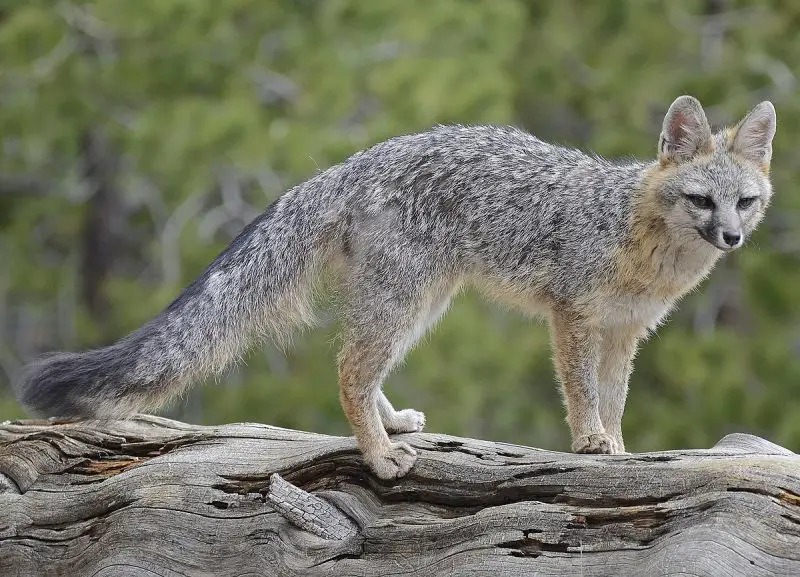When you picture the forests of Texas, your mind might drift to towering pines, sprawling oak woodlands, and the gentle rustle of leaves under a golden sun. But hidden within this natural beauty lurks one of the Lone Star State’s most elusive and fascinating creatures—the gray fox (Urocyon cinereoargenteus). While red foxes often steal the spotlight, gray foxes are true forest phantoms, thriving quietly in both the dense thickets and rugged canyons of Texas.
From their unique ability to climb trees to their nocturnal hunting strategies, gray foxes possess secrets that even lifelong Texans might not know. They are intelligent, mysterious, and remarkably adapted to the varied ecosystems across the state.
This article dives deep into the hidden world of gray foxes in Texas forests, exploring their habits, habitat, diet, and the untold mysteries behind their survival.
Understanding the Gray Fox: An Overview

The Rare Tree-Climbing Fox
Unlike most members of the canine family, the gray fox is an exceptional climber. Equipped with strong claws and flexible forelimbs, it can ascend trees to escape predators, rest safely, or even hunt for birds and eggs. This unique skill sets it apart from the more common red fox, making it one of the only tree-climbing canids in North America.
You’ll often find gray foxes resting on low branches or even denning in hollow trees, especially in heavily wooded regions of East and Central Texas. Their agility and stealth allow them to blend effortlessly into forest life, unseen by most who wander beneath the canopy.
Distinguishing Features
Gray foxes are slightly smaller than red foxes, typically weighing between 8 and 15 pounds. They have a distinctive grizzled gray coat, a black-tipped tail, and a white underbelly. Their face features reddish patches and dark stripes that run down their muzzle, creating a striking appearance in the dappled forest light. These traits help them remain camouflaged while hunting or evading larger predators.
Where Gray Foxes Thrive in Texas
Texas Forest Habitats
Gray foxes are incredibly adaptable, inhabiting a wide range of forest ecosystems across Texas. They prefer areas with dense underbrush, thick vegetation, and nearby water sources, all of which provide shelter and hunting opportunities. You can find them thriving in:
- Piney Woods of East Texas, where loblolly pines and oaks dominate.
- Post Oak Savannah, a transition zone offering mixed woodlands and open fields.
- Edwards Plateau, featuring rugged limestone terrain and juniper thickets.
- Trans-Pecos Mountains, where rocky canyons and brushlands offer solitude.
In these environments, gray foxes maintain small territories, usually no larger than a few square miles, which they mark using scent glands and vocalizations.
Adapting to Human Proximity
Although gray foxes prefer secluded forests, they have gradually adapted to the encroachment of suburban areas. You may occasionally spot them near rural homes, barns, or ranch edges, especially where woodland cover still exists. Their shy nature and nocturnal habits make encounters rare, but their presence is often indicated by tracks or scat left near trails.
Behavior and Lifestyle of Gray Foxes
The Secretive Nocturnal Hunter
Gray foxes are primarily nocturnal, coming to life after dusk. They hunt alone, relying on keen senses of hearing and smell to detect small prey. During daylight hours, they retreat to dens hidden among tree roots, hollow logs, or rocky crevices.
Their solitary lifestyle doesn’t mean they’re antisocial, though. During breeding season, gray fox pairs often share dens and hunt cooperatively to feed their young. Their communication includes soft barks, growls, and yips used to warn, attract, or locate each other.
A Balanced Diet
Gray foxes are omnivores, consuming a mix of animal and plant material depending on the season. Their diet includes:
- Small mammals like rabbits, mice, and voles
- Insects such as grasshoppers and beetles
- Fruits and berries from native plants, especially persimmons and prickly pear
- Occasional birds, reptiles, and amphibians
This diverse diet allows them to thrive in various ecosystems throughout Texas. In fall and winter, fruits become scarcer, and they rely more heavily on small mammals to sustain their energy.
The Role of Climbing in Hunting and Escape
Tree climbing offers the gray fox more than just safety. It gives them access to unique food sources, such as bird nests or fruits high in the canopy. When pursued by coyotes or domestic dogs, they can quickly scale a tree to evade danger—a rare survival skill in the canine world.
Reproduction and Family Life
Mating and Denning
Gray foxes typically mate between January and March. After a gestation period of about 53 days, the female gives birth to a litter of 3 to 5 kits in a well-hidden den. Dens are often reused year after year and may be located in hollow trees, rocky outcrops, or dense brush piles.
The mother remains with the kits for several weeks while the male hunts and brings food. By late spring, the kits begin exploring outside the den, learning essential hunting and climbing skills through play.
Raising the Young
Both parents are involved in raising the kits, providing food and protection until the young are ready to venture out on their own by early fall. The family bond remains strong for several months, with the kits sometimes staying near their birthplace through the winter before dispersing to establish new territories.
The Role of Gray Foxes in Texas Forest Ecosystems
Gray foxes play a vital role in maintaining ecological balance. As omnivores, they help control rodent populations and spread plant seeds through their droppings. Their predation on small mammals and insects prevents overpopulation, contributing to a healthier and more diverse forest environment.
They also serve as prey for larger predators like coyotes, bobcats, and raptors, creating a balanced food web within Texas’s wild landscapes. Without gray foxes, these ecosystems could face disruptions in both predator-prey dynamics and vegetation regeneration.
Threats to Gray Foxes in Texas
Habitat Loss
As Texas continues to urbanize, gray foxes face growing pressure from habitat fragmentation. Logging, road construction, and housing developments reduce the dense cover they need for shelter and hunting. Even though they are adaptable, their survival heavily depends on access to wooded areas.
Predators and Human Conflict
Coyotes are one of the main natural threats to gray foxes. These larger canids often outcompete or even prey upon them. Humans also pose risks through vehicle collisions, trapping, and illegal hunting. However, regulated trapping of gray foxes for their fur has significantly decreased in recent years.
Disease and Parasites
Like other wild carnivores, gray foxes are susceptible to diseases such as rabies, canine distemper, and mange. These diseases can spread rapidly in areas where populations are dense or where they come into contact with domestic animals.
How Gray Foxes Differ from Red Foxes
Many Texans confuse gray foxes with their red counterparts, but there are key distinctions between the two species. While red foxes prefer open fields and farmlands, gray foxes are true forest dwellers. The gray fox’s ability to climb trees is another major difference, as red foxes remain ground-bound.
Additionally, gray foxes have shorter muzzles and rounder faces, with less bushy tails compared to red foxes. Their calls also differ, with gray foxes emitting harsher, shorter vocalizations. Understanding these differences helps wildlife enthusiasts identify which species they’ve encountered in the wild.
Conservation Status of Gray Foxes in Texas
The gray fox is not currently listed as endangered or threatened in Texas. In fact, populations remain relatively stable due to their adaptability and wide range. However, conservationists continue to monitor their numbers closely, especially in rapidly developing regions where forest cover is disappearing.
Maintaining corridors of native vegetation and protecting riparian woodlands are key to ensuring the species’ long-term survival. Wildlife agencies also promote coexistence through education, helping landowners recognize the benefits of having gray foxes nearby.
Fascinating Facts About Gray Foxes
- Gray foxes can climb trees up to 30 feet high and often descend headfirst.
- Their tracks are smaller than those of domestic cats and have visible claw marks.
- They are among the oldest species of canids in North America, dating back 3.6 million years.
- Gray foxes are monogamous, often forming lifelong pairs.
- They can run up to 28 miles per hour when chasing prey or fleeing predators.
- Despite their shy nature, they adapt surprisingly well to semi-urban environments with adequate cover.
How to Spot Gray Foxes in Texas Forests
Gray foxes are elusive, but patient wildlife enthusiasts might catch glimpses of them in forested areas during dawn or dusk. Look for signs such as tracks, scat, or claw marks on tree trunks. If you’re exploring regions like Sam Houston National Forest or Lost Maples State Natural Area, keep your eyes peeled near brush piles or stream edges.
Avoid using bright lights or loud noises, as gray foxes are extremely wary of human presence. Binoculars and trail cameras are great tools for observing their behavior without disturbance.
Coexisting with Gray Foxes
If you live near forested or rural areas in Texas, it’s possible gray foxes are part of your local ecosystem. They rarely pose any threat to humans or pets. To coexist peacefully:
- Avoid leaving pet food outside overnight.
- Secure garbage bins with tight lids.
- Protect backyard chickens or small pets with proper enclosures.
- Enjoy their presence from a distance—they are vital for controlling rodents and maintaining natural balance.
By fostering a respectful attitude toward these nocturnal hunters, you help preserve one of Texas’s most intriguing forest residents.
Gray Foxes and Texas Folklore
In some rural communities, gray foxes have appeared in folklore as symbols of cleverness, transformation, and resilience. Indigenous tribes viewed them as tricksters and guides between worlds, admired for their intelligence and adaptability. Even today, spotting a gray fox is often seen as a sign of balance in nature, reminding us that wildness still thrives amid Texas’s growing urban landscapes.
FAQs About Gray Foxes in Texas
Are gray foxes dangerous to humans?
No, gray foxes are naturally shy and avoid human contact. They are not aggressive unless cornered or threatened. Most sightings occur at night, and they quickly retreat when approached.
Do gray foxes live only in forests?
While forests are their preferred habitat, gray foxes also inhabit brushlands, canyons, and even semi-urban areas with enough vegetation. Their adaptability allows them to survive across much of Texas.
What should I do if I see a gray fox near my home?
Simply observe from a distance. Gray foxes usually pass through in search of food and will not linger unless food sources are available. Remove attractants like pet food or fallen fruit.
Can gray foxes climb fences?
Yes, gray foxes are excellent climbers and can scale fences if motivated, especially when chasing prey or seeking safety.
Do they hibernate in winter?
No, gray foxes remain active year-round. Their dense fur keeps them warm, even during the cold months in northern Texas.
Conclusion
The gray fox may not be as famous as the red fox or as bold as the coyote, but within Texas forests, it reigns as one of the most versatile and enigmatic creatures. Its climbing abilities, intelligence, and adaptability make it a symbol of survival in an ever-changing landscape. As urban sprawl continues to reshape Texas, the quiet persistence of the gray fox serves as a powerful reminder that nature’s resilience endures—often hidden in plain sight among the oaks and pines.
So, the next time you wander through a Texas woodland, pause and listen. The faint rustle in the brush might not be the wind—it could be a gray fox, watching silently from the shadows, carrying centuries of wild wisdom in its amber eyes.






